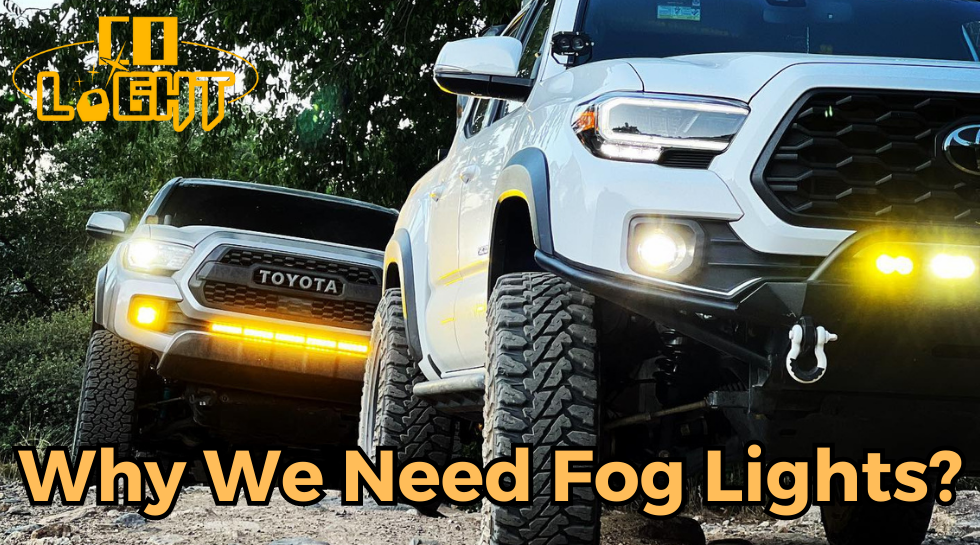You may have experienced driving in rain and fog and noticed that halogen or LED (xenon) headlights easily reflect in extreme weather. When encountering rain and fog, the white fog can obscure the road in front of you. However, if you turn on the headlight yellow fog lights, they have better penetrating power due to their yellow light, which can penetrate the fog. Additionally, their light dispersion is shorter, allowing you to see the road more clearly when driving and ensuring safe driving.
What do you think of the role of fog lights when driving? Why we need fog lights and are they important? In this article, we will explain what fog lights are, their purpose, circumstances in which to use them, and related issues.
What are fog lights? what do they do?
Fog lights are typically installed in both the front and rear of an automobile and are employed to illuminate the road while driving in rainy or foggy conditions, as well as to provide enhanced visibility and safety warnings to other motorists.
The forward-facing fog lamp is generally mounted slightly lower than the headlights and emits a strong, yellow anti-fog light capable of improving visibility for drivers and other road users, enabling them to recognize each other at longer distances.
Meanwhile, the rear-facing fog lamp is located on the back of the vehicle and emits a more intense red signal light than the taillights to aid other drivers in detecting the vehicle during times of low visibility, such as in fog, rain, or dust. This article will focus primarily on the functions of front-facing fog lamps and associated considerations.
When should I use my fog lights?
- Foggy conditions: When you encounter foggy conditions where visibility is impaired, it is appropriate to use your fog lights. Fog lights are positioned low on the front of the vehicle and emit a wide, low beam pattern that helps illuminate the road closer to the ground, reducing the glare caused by the fog and enhancing your visibility.
- Heavy rain or snow: During heavy rain or snowfall, when the water or snow particles in the air create a similar effect to fog, it may be necessary to use your fog lights. The low beam pattern of fog lights can help cut through the precipitation and improve your ability to see the road and be seen by other drivers.
- Mist or haze: In conditions of mist or haze that significantly reduce visibility, it is advisable to use your fog lights. These conditions can occur in mountainous areas, coastal regions, or during certain weather patterns. The wide, low beam of fog lights can help enhance your visibility and improve safety.
Remember the following considerations:
- Only use your fog lights when necessary and when visibility is significantly reduced. Using them in clear weather conditions can cause unnecessary glare and may distract other drivers.
- Fog lights are not a substitute for headlights. They should be used in conjunction with your low beam or daytime running lights, depending on the legal requirements in your area.
- Be mindful of other road users. While fog lights can improve your visibility, they can also cause glare for drivers in front of you or coming from the opposite direction. Use them responsibly and consider turning them off when approaching other vehicles.
Always check the regulations in your specific jurisdiction as laws regarding fog light usage may vary. It's important to use fog lights responsibly and consider the safety of yourself and other drivers on the road.
Can I use fog lights in place of regular headlights?
Don‘t use fog lights in place of regular headlights.
Fog lights are specifically designed for low-speed use in conditions of poor visibility, such as fog, mist, and snow. They differ from daytime running lights and are an additional set of lights mounted low on the vehicle. Their purpose is to prevent fog from settling on the road by projecting light into a layer of air suspended 12 to 18 inches above the road. These lights are also positioned to the right to help the driver see the solid white "fog line" at the edge of the road, which serves as a guide.
Every component of a vehicle serves a distinct purpose, and no single part can replace another. Fog lights are designed to help drivers navigate through inclement weather, particularly fog. However, it's important to note that these lights aren't designed to illuminate the road over long distances, unlike headlights.
Although not all vehicles are equipped with fog lights, all vehicles come equipped with headlights. It's crucial to use headlights when they're appropriate, while fog lights are intended to complement headlights during inclement weather.
Are fog lights required by law?
Typically, operating a vehicle with your fog lights activated is legal. However, in certain circumstances, utilizing fog lights could result in potential legal consequences. The legislation regarding fog lights may vary somewhat by jurisdiction, but generally, fog lights can be deemed illegal if:
- The fog lights installed on the front bumper are situated too high
- Fog lights feature a hue other than white or yellow
- The use of fog lights affects the visibility of other motorists.
Can I install fog lights myself? Or do I need professional assistance?
If you don't know anything about fog lights, you may need professional assistance. If you know about the car, you can install fog lights by yourself.There are two ways to upgrade fog lights, one is to update the headlight bulbs, you can replace the halogen bulbs with LED bulbs or lens bulbs.
If choose the led light bulbs, such as K1, F2D Plus, V20 light bulbs are good choice. With yellow beam and can be used as fog lights. Led and lens bulbs are different because there is no clear cut line. You can choose the light bulb you want according to this feature.
If choose the lens light bulbs, such as Y7S light bulb. The most distinctive feature of Y7S light bulb is the three-color light, which is 6500K white light, 4300K yellow-white light, and 3000K yellow light. White light is suitable for driving in normal weather, the road is brighter, reducing visual fatigue; yellow light is suitable for driving in rain and fog, with strong penetrating power and safe driving. But the bulb plug type is less than led light bulbs.
Fog light installation steps:
- Park the vehicle on a level surface and apply the parking brake.
- Open the hood and locate the fog lights under the headlights.
- Remove the gasket, bolt and nut and remove the housing.
- Insert the new fog lights. Make sure the bolt holes are aligned, otherwise you may have to drill new holes.
- Insert the bolt. Thread the washer and nut onto the bolt and tighten with a ratchet or wrench. Do not overtighten as you may damage the fog light housing or the vehicle.
- Reinstall the switch. Reconnect the fog light switch with the clips.
- Activating the ignition and test the fog lights. Make sure the angle is conducive to vision and does not shine into the eyes of other drivers.
Such as DB-P series is not only an auxiliary driving light, but also a fog light.
@hooligan_offroad installed the DB-P series in the bumper position, so he can see the road in front of you even in snowy days.
Safety is always of paramount importance when driving. Fog lights serve as an auxiliary lighting device to help us better cope with the challenges of low visibility in adverse weather conditions. By using fog lights wisely and following regulations and road safety guidelines, we can improve our own safety on the road, as well as being responsible for the safety of other drivers and pedestrians.
Hope that this blog has helped you to understand fog lights and motivated you to use them more responsibly and cautiously when driving in the real world. Should you possess professional advices, we would greatly appreciate your sharing them.



